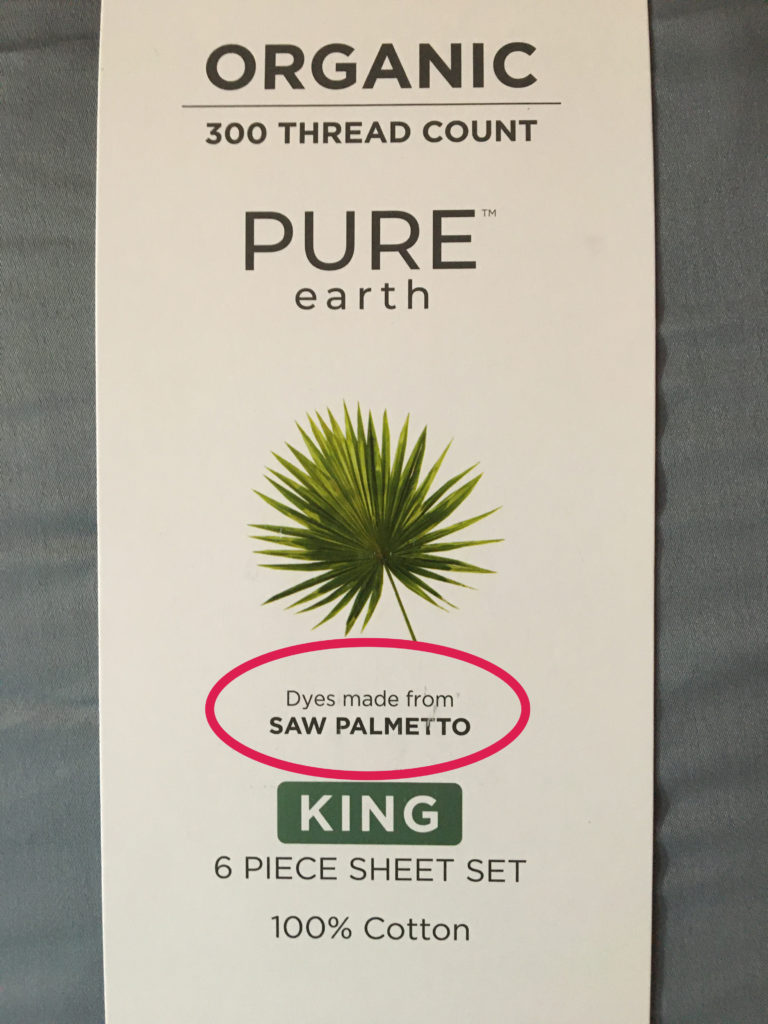While shopping recently in Costco, I notice a set of gray bed sheets whose package sported a palm leaf logo underneath which was the extraordinary statement, “dyes made from saw palmetto.” The same company offered olive green sheets with the claim “dyes made from saw palmetto fruits.” Saw palmetto (Serenoa repens) is a dye plant? This question sent me down a rabbit hole finding out about palms as dye plants.

Plants have been sources of dyes for millennia. Even in this age of industrial chemistry, some dyes (indigo, henna) are still extracted from their natural, botanical sources. Making dyes from plants does, however, involve some trial and error. For one thing, there is not a simple correspondence of color. In other words, orange fruits may not yield orange dye, and green leaves do not necessarily tint fabric green. Another problem is getting the dye to stick so that it does not wash out during laundering.
Aside from the unusual red pigments in the dried resin (“dragon’s blood”) of certain rattans, the colors we see in palm stems, leaves, flowers, and fruits are the typical anthocyanins and carotenoids found throughout the plant kingdom. As far as we know, palms don’t have any special pigments that might be exploited by dyers. Extracting these pigments is easy enough: grind or macerate the plant material in water. The colors of anthocyanins and other natural pigments are dependent of the pH of the solution in which they occur – be it in the plant cell or the dyer’s kettle. Acidity can be adjusted by adding chemicals such as aluminum sulphate. The next step in dying is mordanting the fibers, a process that prepares the fibers to receive the dye and makes the dye stick. Mordants are a chemical bridge that attaches the dye molecules to the fibers; without a mordant, the dye will not be color fast.
Surveying the ethnobotanical literature, I found only a few indications of palms being used as dyes by indigenous cultures. For example, Euterpe precatoria fruits yield a red dye that has been used in Peru to color the fibers of Astrocaryum chambira used in weaving handbags and hammocks. More often, I found reports that explored the potential of sourcing dyestuffs from palms that were already being cultivated on an agronomic scale. These were reports of efforts to extract dyes from coconut husks or betelnut fruits. These palms tended to yield dyes in shades of brown, reddish brown, gray, or black.
What about “dyes made from saw palmetto”? The dyes are supplied by Archroma, a Swiss-based company that produces textile dyes. Their plant-based dyes are touted as sustainable and less toxic to manufacture and use. Archroma is finding ways to use agricultural waste and profitably turn it into textile dyes. In the case of saw palmetto, Archroma is using the residues from the production of saw palmetto nutritional supplements. Fruit residue yields the green, and leaf residue yields the gray dye. [I am uncertain about this latter claim, as saw palmetto leaves are not – or should not – be harvested for supplements.]
I welcome the textile industry taking a hard look at toxic waste and sustainability. And up-cycling waste products is a good thing. If palms can play a part in bringing positive changes to the industry, then I shall sleep more soundly on my palm-dyed sheets.
Scott Zona
